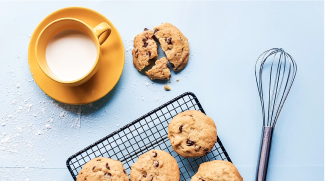If this is the first time you hear about Spotify Editorial Pitching, don't worry! By the time you finish reading this article and listening to our podcast, you'll be ready to dive head-first into the world of pitching and hopefully expect your first editorial placement!
You can listen to the 2nd episode of Fox Tales, our brand-new music industry podcast on Spotify & Apple Podcasts. If you find the episode helpful, leaving a review would mean the world to us.
It's no secret - landing that editorial placement is the ultimate goal for many artists, especially emerging ones. When you do, voila, your numbers spike up - streams, followers, and inevitably - the royalties.
Before digging into this, we highly recommend checking out our article on Spotify's editorial and algorithmic ecosystem where we provide an in-depth explanation of the types of playlists and their importance for both artists and Spotify themselves.
What’s a Spotify Editorial?
Spotify is full of huge playlists that were carefully curated to suit different occasions, activities, or moods, or are simply the crème-de-la-crème of a genre. Needless to say, they are heavily promoted by the platform and take prime space in their desktop and mobile apps. In a nutshell - the essence of Spotify's unique listening experience for each user.
Stay up to date.
New music and exclusive updates in your inbox weekly.
While Editorial playlists were not a Spotify feature initially, the company quickly realized their potential after analyzing the performance of a fellow Swedish company called Tunigo who by that time (2013) was curating hundreds of customized playlists for Spotify users. Given the high engagement on those playlists, acquiring Tunigo was a no-brainer, and developing those playlists helped Spotify differentiate itself early on not only as a place to stream music but also as a curator.
A lot has happened since then, something we discuss in our Spotify playlist ecosystem article, but one thing's for sure - editorials are at the center of discovery within the Spotify ecosystem with 30% of streams on the platform being done on one of the thousands of editorials.
Fun fact - by 2017 Spotify had employed around 150 curators responsible for the editorials. Some of the ones we’ve been following and love are lofi beats, Jazz Vibes, Chillout Lounge, Lounge - Soft House, Chill Tracks, Fresh Finds, and Afterhours.
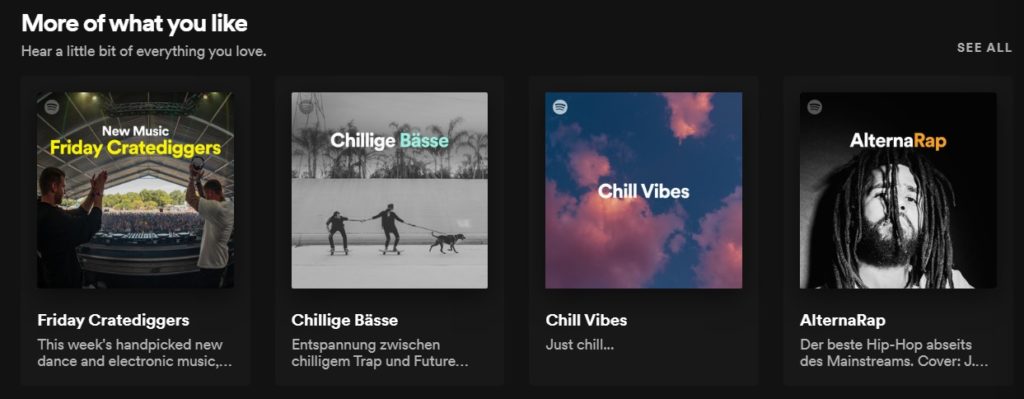
Fresh Finds is an interesting case. Started by one of Spotify's most prominent editors Athena (who is not with the company anymore), Kurt, Dan, Jason, and Brian in 2015 it recently got its own billboard solidifying it as an institution within the editorial ecosystem. The playlist is noted to be taking into consideration the opinion of external tastemakers and leveraging data (I guess blog and influencer features?).
Besides recommendations based on your taste, the Home section of Spotify's desktop app also suggests editorial playlists based on specific moods.

Feeling zen, sad, or happy? The curators got you covered.
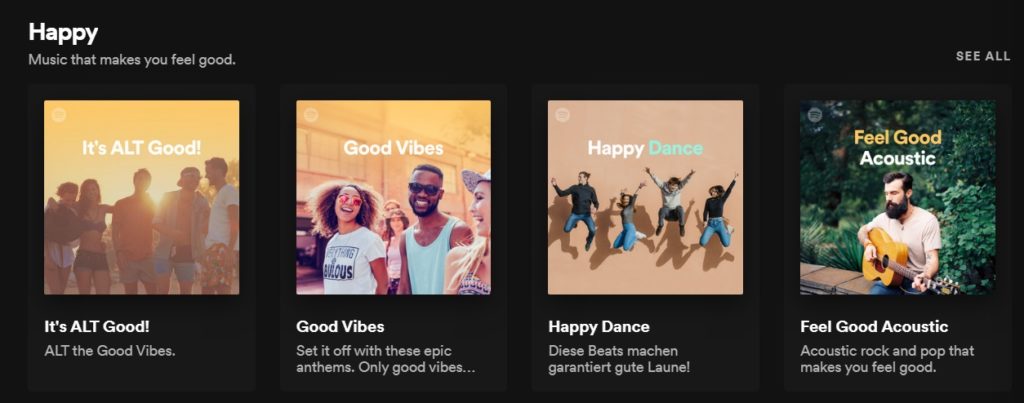
Fast-forward to 2021 in a digital age where user privacy and tracking across devices is slowly disseminating, the platform is presented with another opportunity created thanks to their mood and activity editorials. Spotify gives advertisers on its platform the opportunity to target people in specific moods and situations and circumvent pixels and user tracking - an issue Facebook's currently facing. Think about it - what's a better spot for your audio ad for pasta sauce than Cooking with Soul - a really smooth playlist on Spotify. Selling workout equipment? Yoga Electronica and Morning Run got you covered. You get the idea.
Anyhow. Back on the topic.
Spotify has really changed the game - it is at the time of writing this the only streaming platform that allows EVERY SINGLE artist out there to send their music for consideration, whether that's Rihanna or a bedroom producer who is just starting out. You have a chance to impress the curators at Spotify even though it might be your 1st or 2nd release and you have just a handful of followers. If they see the potential in your music and you as an artist, you might get supported right away. This is literally what happened to our Verdance release last year.
Presenting yourself in the best light possible, however, is no easy task and in this article, we're covering our opinion of what's important when it comes to pitching to Spotify's editorial team... and why you should always do it.
Why Pitching Your Music to Spotify is Important?
You’ve got no chance of getting heard by the Spotify curators, let alone getting into an Editorial – unless you pitch it via S4A. Sure, there are probably exceptions but you don’t want to rely on those odds, believe me. Also, this is the way to be included in your fans’ Release Radar playlist, something we cover later in this article.
While there is no clear formula, we’ve gathered a couple of years of experience and know-how that you might find useful. Dig in.
What is Spotify for Artists (S4A) and Why You Need It
Everything pitching-related begins with S4A. If you want to pitch your music, you’re going to need access to Spotify for Artists (or S4A) – the place where the magic happens. You can also use it to find your stats and use some cool functionalities, e.g. Canvas, Artist Pick & more. Claim it here and follow the instructions.
If it’s your first release, ask your distributor for your artist URI, and make sure you have artist socials – Instagram, Twitter, etc.
Before you start, there are a few things to take into account.
Superb Music Quality
This goes without saying but I’ll mention it anyway – make sure your music is on point. A low-quality track, consisting of a 16-bar loop with overused samples, that hasn’t been properly mixed/mastered doesn’t stand a chance. Bring your A-game.
Captivating Artwork
The same applies to the artwork - do the best you can, ask for help from a designer friend, or simply browse through websites for royalty-free images, like Unsplash.
It should reflect your artist brand, the mood and vibe of the track, and most importantly - your vision.
Track Length
People often ask whether the track's length might impact being featured in editorial. Technically, it should not... but do bear in mind that each editor goes after a particular vibe/setup and specifics, so your 8-minute song might not be a great fit for a playlist of the same genre where tracks are rather short and on-the-spot (3 to 4 minutes).
Track Name
We can't say that's really important, but we always advise artists to avoid generic names. "Jazz Beat" isn't sexy enough, sorry.
Bio, Canvas and Artist Pick
Spotify likes it when you use all its functionalities, and it actively encourages everyone to do it. And it’s free so don’t be lazy – have a bio (at least 1500 characters), pictures, social media links, make sure to utilize the Spotify Canvas, the Artist Pick, etc.
Make Sure Your Socials Work For You
Spotify curators also look at your socials and Google you to evaluate your potential – so make sure you’re active and you’ve created a good artist brand. You can take a look at our Building The Music Brand of an Artist article for more info.
Know Your Music Meta Tags
Yes, your feelings & opinions about the track are important. However, Spotify is very much algorithm-based, and providing (the right) metadata to the editors will certainly help them, and essentially – you. Cyanite is a great AI tool that analyzes your track’s mood, genre & more. We suggest using it and at least having the data in mind.

When is The Right Time to Pitch?
Make sure your music is submitted for digital distribution as soon as you're ready and happy with the sound and visuals. The earlier - the better. Once your track is visible on your Spotify for Artists dashboard, you're ready to pitch. We advise you to do this 4 to 5 weeks before the actual release date.
There have been cases when last-minute pitches have resulted in Editorial placement but you don't really want to rely on this.
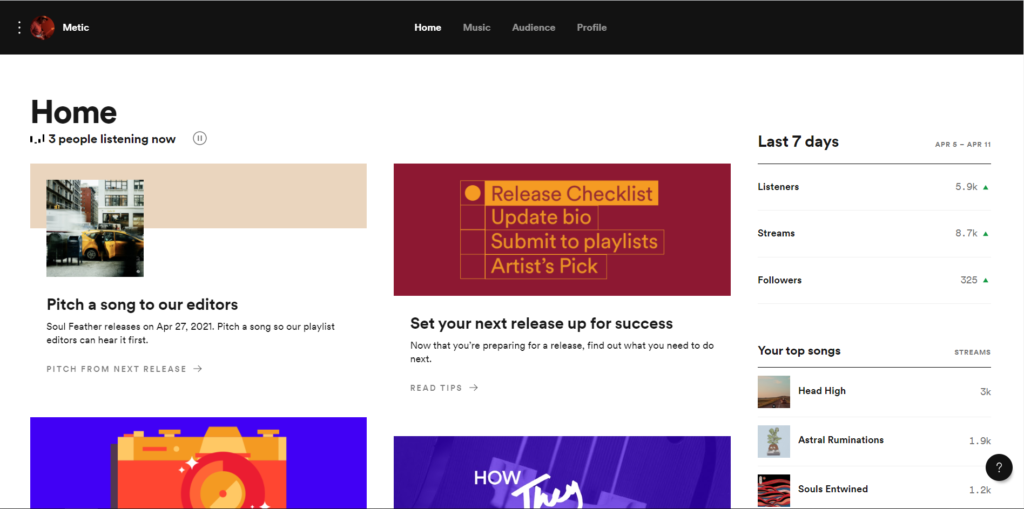
Things to Consider When Pitching
- You can only pitch an unreleased song and you can only pitch 1 track from an EP/album, so pick the best one. Bear in mind the editors might still choose another track from it.
- Unfortunately, you cannot pitch a song if it's part of a compilation, or if you're a featured artist. You have to be listed as the main artist in both the album/single and the track itself.
- You can only pitch one song at a time – meaning, the one that you already pitched should be released first, to be able to pitch a new song.
- Working with a label, publisher, marketer, or manager? You can add these people to your S4A team. You can discuss who’s better to submit the pitch - although this isn't proven, having historic success with Editorials is probably a good sign.
The Pitching Process, Step-by-Step
First, you need to log in to your Spotify for Artists. Go under Music/Upcoming;
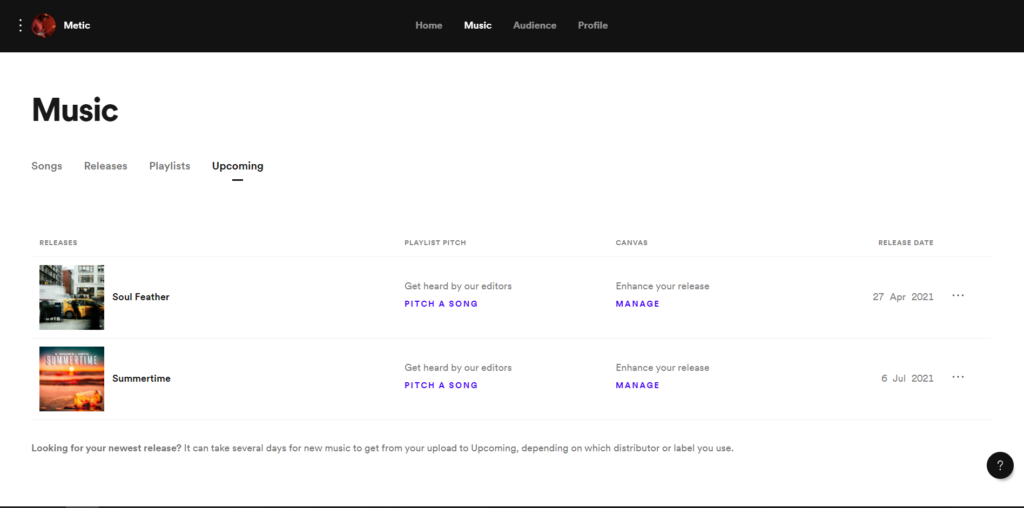
Select the team you're pitching from (Artist, Label, Manager, etc.).
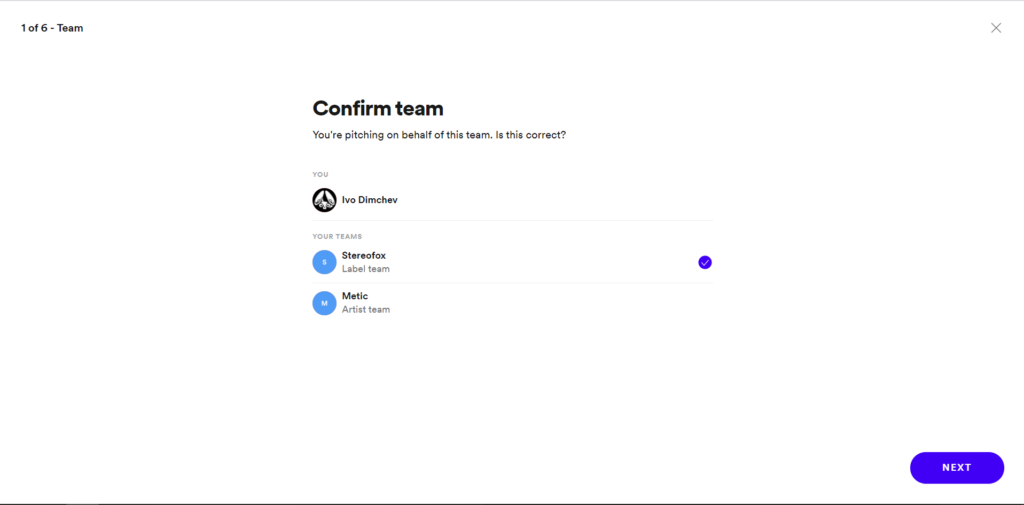
Choose a release
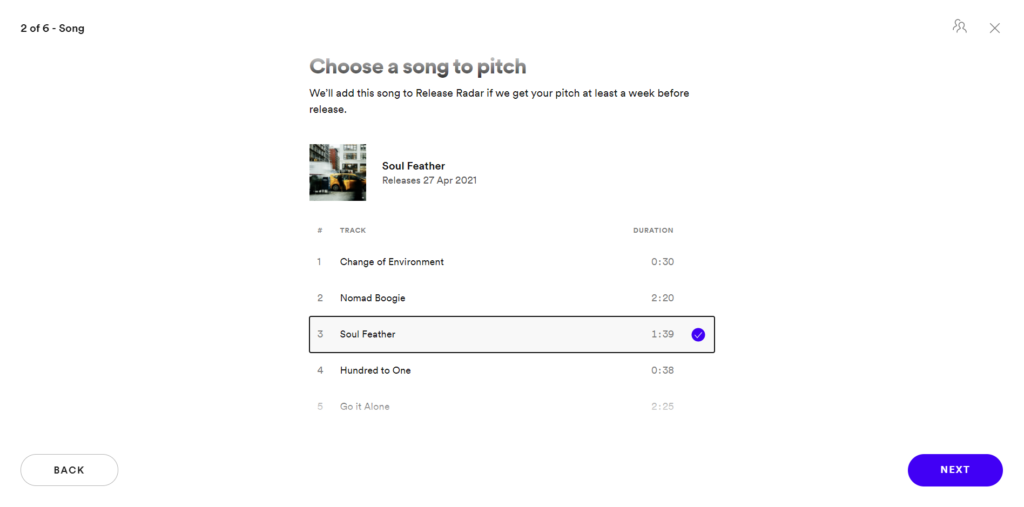
Select the actual hometown and the current location of the artist – some Spotify playlists are location-based and target specific audiences.
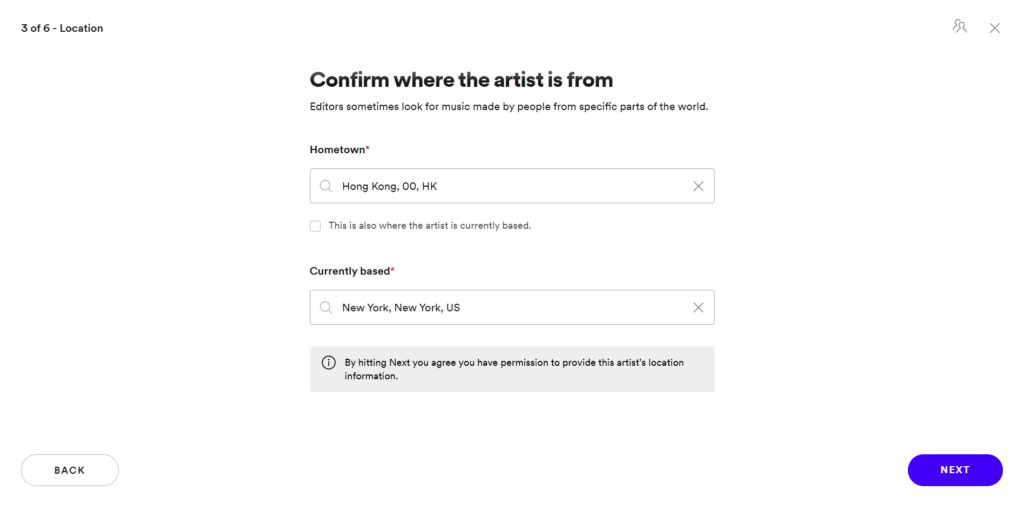
Spotify recently included a huge number of sub-genres – you can select up to 3. Try to find the most suitable ones that completely “explain” your song.
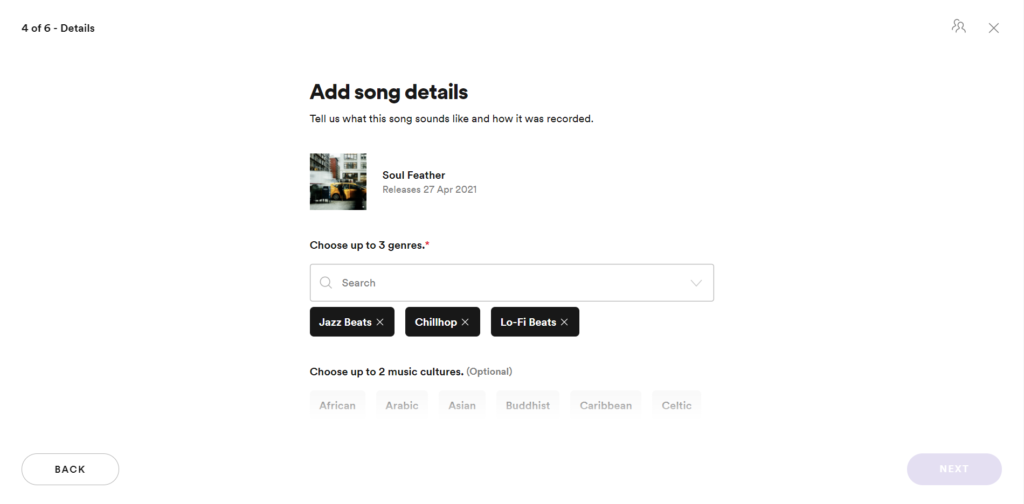
Provide as much info as possible but do not overdo it – meaning don’t select irrelevant tags. Be accurate and thorough – so the track goes to the right people. Often, editors are looking for African/Hindu/etc. cultural-influenced songs, or specific instrument-driven (e.g. acoustic guitar), or certain moods (chill, energetic, etc.) so definitely check all the relevant boxes.



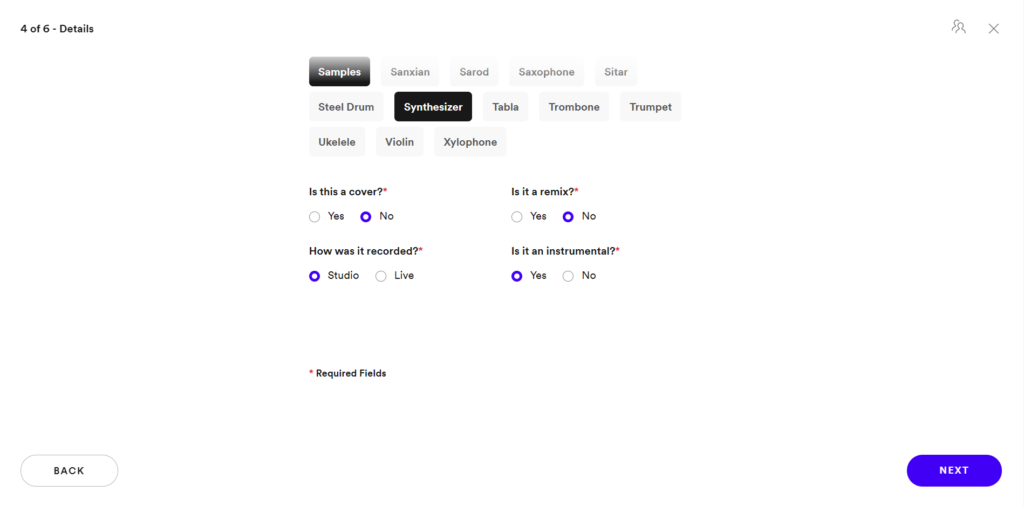
Spotify Meta Data, How Does it Work and Why It's Important
Now that we've walked you through the pitching process, it's important to explain why you should care about all of these fields and how crucial the information accuracy is.
All that information Spotify asks you to fill is there for a reason. Each input field, string, and checkbox. All of your track metadata gets bundled together and goes into the editor's database/back-end (not sure what else to call it). It's that database that they query or hop on whenever possible. Besides checking the queue, editors can query and request tracks with specific features. Imagine someone wanting to add a lo-fi house with sax to their editorial playlist? The way to do this is to filter based on those characteristics and if your metadata is incomplete you might ruin your chance of getting heard.
Editors can also put notes or label tracks which they like, but find not suitable for their particular playlist, so all of this comes in handy. The goal of the metadata is to make their research work easier and more accurate and it's on you to provide the right description of your sonic creation.
How to Write Spotify Playlist Pitch
The most important thing, I’d say. You only have 500 characters and you should use them wisely – and editors say you need to try to come as close to 500 as possible.
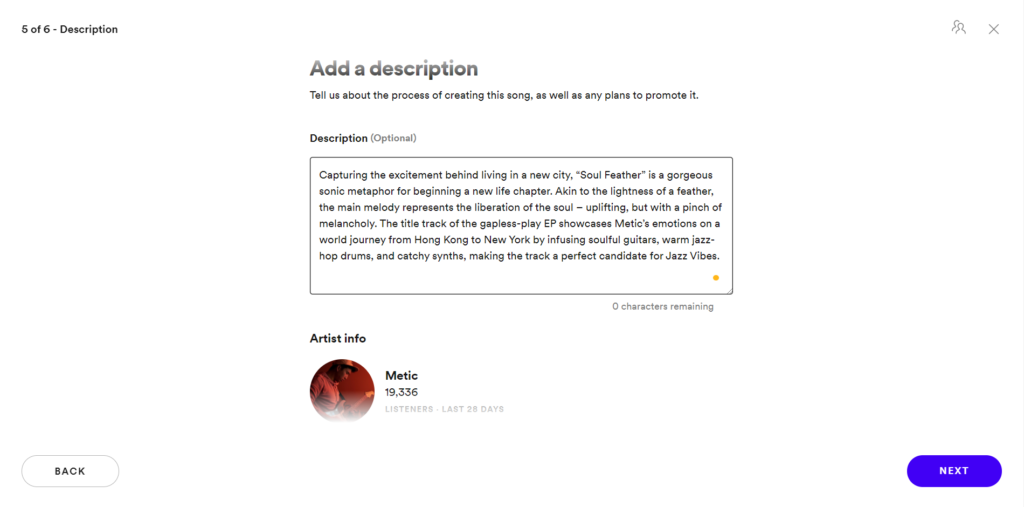
The text has to be a good balance between the story, your artistic approach, the process behind creating the song, as well as previous success, your credibility, how you plan to promote the release, and in which Spotify Editorial would the track fit (show them you’ve done your homework).
Spotify curators love context & community, and take into account each Editorial playlist’s theme, genre, mood, audience, how famous or emerging the artists are, etc., so try to help them out with your initial research (although you might get added to a different playlist).
Also, don’t be shy from telling them if you’ve collaborated with someone famous, featured on a specific music blog, if you’ve been noticed by BBC One, or opened a big festival.
Obviously, you cannot possibly include all this info in 500 characters but try to think what the most important aspects of you and your music are. Be a good storyteller (or find someone who is). Captivate the editors with your unique and powerful story. And then they’ll definitely hear your song.
Best Spotify Playlist Pitch Examples
Again, there’s no formula but here are some of our best pitches we’ve sent that resulted in additions to different Spotify Editorials:
Houndtrack is an LA-based producer who opened for Medasin & Fakear last year. He is very much inspired by nature & nostalgic memories when making music - you can often hear the sounds of waves & crunching leaves, fused with synths & beats. "Cul de Sac", his first release with Stereofox Records, tells a story about his childhood street, where all the kids used to skateboard, have lemonade stalls & had Halloween trick-or-treats. Simply a reflection of those carefree times.
Emerge from the blues of 2020 with this mellow lofi piece that blossoms like a flower - from melancholy to enlightening hopefulness. Japanese producer yuhei miura and renowned Tokyo guitarist Kazuki Isogai team up again for a 6-track EP, Better Days - to bring warmth and assurance for a brighter future. The first single “Hope” envelops captivating guitars and smooth beats - a sound they’ve proven to be dear to the audience of the Spotify Editorial playlists. A perfect addition to Lo-Fi Beats.
Meet the newly born, nature-inspired electronic side of producer Handbook. After growing his beat moniker for 10 years,the UK artist goes beyond the confines of hip hop music in order to heavily emphasize imagery and mood by exploring the depths of deep house, chill techno, and downtempo music. “Ritual Two” is the first single from his debut EP with Stereofox Records. Dark and captivating electronica for those late night drives. Perfect fit for your Electronic Rising or Lowkey Tech playlists.
FYI, you can edit your pitch after it’s been submitted, up until the release date. However, it’s not guaranteed that the editors will see the changes.
Release Radar
Besides increasing the chance of landing on Editorial playlist, there's another equally important aspect of pitching - the Release Radar.
Pitching it at least 7 days in advance increases the chances of your release making it into your followers' & listeners' Release Radars. A few specifics to take into account:
- Spotify doesn’t include a song in a listener’s Release Radar if they’ve already heard it (but they might include another song from the release)
- They only include songs where you're the main or featured artist (not remixer)
- They don’t include songs by Various Artists
- They don’t include re-releases of songs already on Spotify
- Each listener only gets one song per artist per week
- They’ll include a song for up to 4 weeks if a listener hasn't heard it
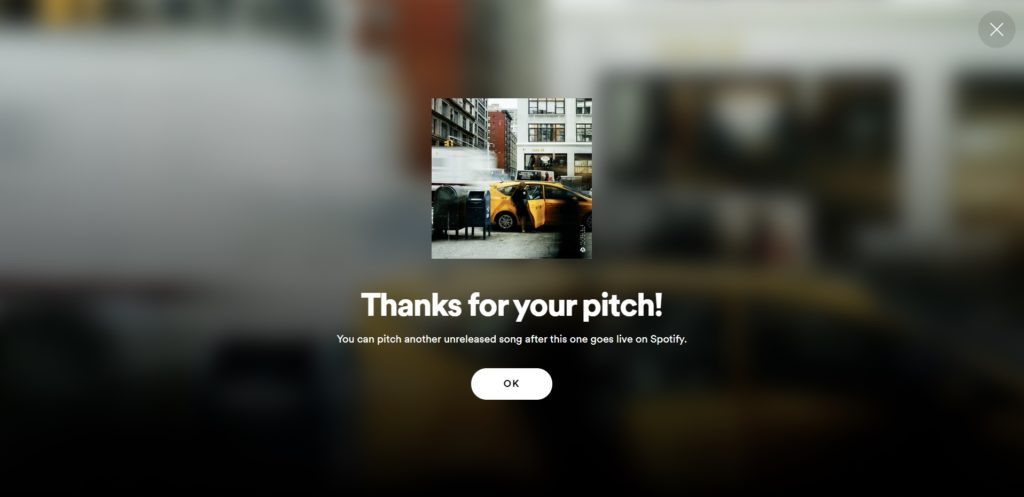
When Will I Get Picked, if Ever?
Well, there isn’t a deadline to be added to Spotify Editorials. Usually, it happens around 2-3 weeks after the release. But we’ve had cases when our releases got added in less than a week, and sometimes more than a month.
Generally, once pitched, the track doesn’t disappear from the Spotify editors’ database – and there’s a chance you get discovered later, especially if there are signals in Spotify’s data that your song is resonating on their platform.
Be as active as possible after your release, promote your music and engage with your audience. Spotify says around 20% of all pitches make it to at least one Editorial playlist, so try to stand out.
Tips & Tricks
- When doing a collaboration with 2 or more main artists, make sure each of them pitches the song. We’d advise you to choose different (but relevant) genres, moods, etc. so you can get a higher chance of being noticed by different editors. Also, you can try different approaches and/or include different info in each pitch text.
- A big amount of pre-saves & artist follows on Spotify is surely a good sign to the editors.
- Try to get into as many independent Spotify playlists & blogs as you can, and get your fans to save & listen to your track from the first day it's been released – this also pushes you up in the search algorithm and shows the editors that your song has potential. It’s not mandatory but we’ve seen it often matters. A few ways to do it are SubmitHub, Playlist Push, Daily Playlists, etc.
- Especially if you’re a label (but also if you’re an artist), we advise you to collect your pitches. Once the track is released, the pitch text is gone forever - unless you put it in a Google Doc somewhere. You can always get back to your old pitches, change your approach or use the structure of an already successful text.
How does the day of a Spotify Playlist Editor look like?
We don't really know or can say for sure, but as far as we know, the team does use a platform called PUMA which stands for Playlist Usage Monitoring and Analysis. The system “breaks down each song on a playlist by things like number of plays, number of skips, and number of saves.” and it also tracks "the overall performance of the playlist as a whole, with colorful charts and graphs illustrating listeners’ age range, gender, geographical region, time of day, subscription tier, and more."
All that information helps the editors make decisions on what might be a good candidate for a certain playlist. However, it is a lot more complicated than that. We imagine editors having access to this back-end database where they can filter out based on genre, mood, instruments in the track, or even locations. From what we've also heard editors can recommend each other tracks and leave notes here and there, which makes metadata accuracy even more important.
Can I Pay to be Included in Spotify Editorials?
No. This is called “payola” and is illegal. It is also against Spotify’s policy and would ultimately result in a ban.
There’s no way to pay to be included in Spotify Editorials – and if someone promises you this, well, it’s a scam. Putting maximum effort, polishing your release & the pitch, plus a pinch of luck is what raises your chances. Also, being consistent.
Don’t forget, getting into a Spotify Editorial is a combination of many factors and has many aspects. It might just mean the right person listened to your track at the right time.
Not getting playlisted also doesn’t necessarily mean your music is bad, sometimes it’s just not the right timing. Always keep pushing and bring the best of yourself.

